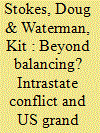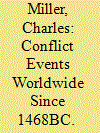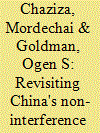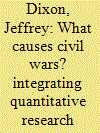|
|
|
Sort Order |
|
|
|
Items / Page
|
|
|
|
|
|
|
| Srl | Item |
| 1 |
ID:
160637


|
|
|
|
|
| Summary/Abstract |
Grand strategic theorists share an historical emphasis on interstate conflict, yet in contrast to the more frequent intrastate conflicts, these represent only 7 of the some 273 US military deployments since 1900. We argue that these intrastate conflicts limit the utility of regional balances of power in mitigating forms of conflict that the US may consider inimical to its national security interests. When considering potential changes to US force posture and grand strategy, American coercive statecraft should be theorised along a broader strategic continuum encompassing the full range of conflict.
|
|
|
|
|
|
|
|
|
|
|
|
|
|
|
|
| 2 |
ID:
189012


|
|
|
|
|
| Summary/Abstract |
Quantitative datasets of international conflict skew temporally to modern times and geographically and culturally to the West. Yet post–1815 conflicts featuring Western actors are only a small part of the history of warfare. Many scholars have bemoaned the potential selection bias which this introduces to studies of the causes and effects of military conflict, but as yet quantitative datasets which remedy both these temporal and geographic shortcomings have been lacking. Some datasets have expanded the scope of existing offerings temporally and others spatially, while others have attempted to expand both but with an important lack of detail in terms of location, participants, timing and outcomes. This dataset sets out to remedy the deficit. Using military history’s most extensive encyclopedia of conflict events, we have created a dataset of conflict events spanning the globe and a timescale from 1468BC to the invasion of Iraq in 2003, complete with precise geographic coordinates, year, participants and outcome. We demonstrate the promise of this data-set by using it to assess the frequently asserted relationship between conflict history and economic development, combined with Nordhaus’ GECON sub–national wealth data and historical data on population density from the Netherlands Environmental Agency.
|
|
|
|
|
|
|
|
|
|
|
|
|
|
|
|
| 3 |
ID:
131994


|
|
|
|
|
| Publication |
2014.
|
| Summary/Abstract |
This article evaluates, through statistical analysis, China's foreign policy of non-intervention, and answers the question of whether or not China has kept to its declared policy regarding intrastate wars relative to the other four powers that are permanent members of the UN Security Council. The evidence in this article suggests that the Chinese policy of non-interference was more a declaration than a policy. China significantly lower only from the United States and the USSR/Russia and differs solely in numbers of interventions, their extent, and diversity. Yet China is the only power that has not sent troops to interfere in intrastate wars. The country's share among the powers in supporting actors in intrastate wars is significantly less as time passes, although China exhibited no significantly different trends between the Cold War and the post-Cold War periods. It is, on the contrary, the United States and UK among the powers that have significantly increased their relative share of interference.
|
|
|
|
|
|
|
|
|
|
|
|
|
|
|
|
| 4 |
ID:
093001


|
|
|
|
|
| Publication |
2009.
|
| Summary/Abstract |
Over the past decade, dozens of quantitative studies on civil war onset have been published. This study compiles the results of 46 quantitative studies, and finds that of more than 200 hundred independent variables, there is some degree of consensus on the effects of fewer than 30 and a high degree of consensus on no more than seven. Furthermore, many puzzles and contradictions in the existing research literature have barely been examined. The review concludes that while there is embryonic consensus on the effects of a small set of variables, there is not yet a widely accepted theory that explains these effects. Since neither qualitative nor quantitative analysis of civil wars has solved these puzzles, future studies of civil war onset should theorize the expected interactions between all variables of interest, collect data on variables with poor proxies, take grievances more seriously in theory and measurement, make use of the enormous quantity of historical scholarship on civil wars, and extend the concept of "multiple paths to war" to intrastate war.
|
|
|
|
|
|
|
|
|
|
|
|
|
|
|
|
|
|
|
|
|